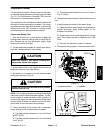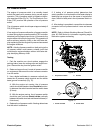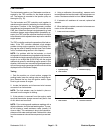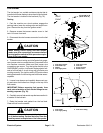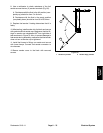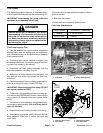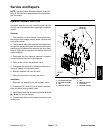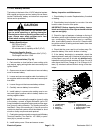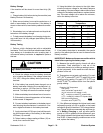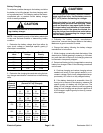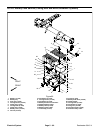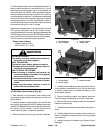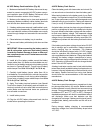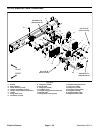
Reelmaster 5010- H Page 5 - 79 Electrical System
Battery Storage
If the machine will be stored for more than thirty (30)
days:
1. Charge battery fully before storing the machine (see
Battery Service in this section).
2. Either remove battery from machine and store on a
shelf or leave battery on the machine. If the battery is
stored on themachine, leavebattery cablesdisconnect-
ed.
3. Store battery ina cool atmosphereto avoid quickde-
terioration of the battery charge.
4. To helpprevent the batteryfrom freezing duringstor-
age, make sure it is fully charged (see Battery Service
in this section).
Battery Testing
1. Perform a high- discharge test with an adjustable
loadtester.This isoneof themostreliable meansoftest-
ing a battery as it simulates the cold- cranking test. A
commercial battery load tester is required to perform
this test.
CAUTION
Follow themanufacturer’s instructions whenus-
ing a battery load tester.
A. Check the voltage across the battery terminals
prior to testing the battery. If the voltage is less than
12.4 VDC, charge the battery before performing a
load test.
B. If the battery has recently been charged, use a
battery load tester following the manufacturer’s in-
structions to apply a 150 Amp load for f ifteen (15)
seconds. This step will remove the surface charge.
C. Makesure battery terminalsare free of corrosion.
D. Estimate the internal temperature of the battery
to the nearest 10 degrees F.
E. Connect a battery load tester to thebattery termi-
nals following the manufacturer’s instructions. Con-
nect a digital multimeter to the battery terminals.
F. Applya testload of270 Amps (onehalf thecrank-
ing performance rating of the battery) to the battery
for f ifteen (15) seconds.
G. Take a battery voltage reading at fifteen (15) se-
conds, then remove the load.
H. Using the table in the column to the right, deter -
mine the minimum voltage for the battery tempera-
ture reading. Ifthe test voltageis below the minimum
voltage for the battery temperature, replace the bat-
tery. If the test voltage is at or above the minimum,
return the battery to service.
Minimum
Voltage
Battery
Temperature
9.6 70
o
F (and up) 21
o
C(andup)
9.5 60
o
F 16
o
C
9.4 50
o
F 10
o
C
9.3 40
o
F 4
o
C
9.1 30
o
F -1
o
C
8.9 20
o
F -7
o
C
8.7 10
o
F -12
o
C
8.5 0
o
F -18
o
C
2. If the battery electrolyte is accessible, the specific
gravity of the electrolyte can be used to determine the
battery condition.
IMPORTANT: Make sure the area around the cells is
clean before opening the battery caps.
A. Measure the specific gravity of each cell with a
hydrometer. Draw electrolyte in and out of the
hydrometer barrel prior to taking a reading to warm-
upthehydrometer.Atthesametimetakethetem-
perature of the cell.
B. Temperature correct each cell reading. For each
10
o
F(5.5
o
C) above 80
o
F (26.7
o
C) add 0.004 to the
specific gravity reading. For each 10
o
F(5.5
o
C) be-
low 80
o
F (26.7
o
C) subtract 0.004 from the specific
gravity reading.
Example: Cell Temperature 100
o
F
Cell Gravity 1.245
100
o
F minus 80
o
F equals 20
o
F
(37.7
o
C minus 26.7
o
C equals 11.0
o
C)
20
o
F multiply by 0.004/10
o
F equals 0.008
(11
o
C multiply by 0.004/5.5
o
C equals 0.008)
ADD (conversion above) 0.008
Correctionto80
o
F (26.7
o
C) 1.253
C. If the difference between the highest and lowest
cell specific gravity is 0.050 or greater or the lowest
cellspecificgravityis lessthan1.225,chargethebat-
tery. Charge at the recommended rate and time giv-
en in Battery Charging or until all cells specific
gravity is 1.225 or greater with the difference in spe-
cific gravity between the highest and lowest cell less
than 0.050. If these charging conditions can not be
met, replace the battery.
Electrical
System



